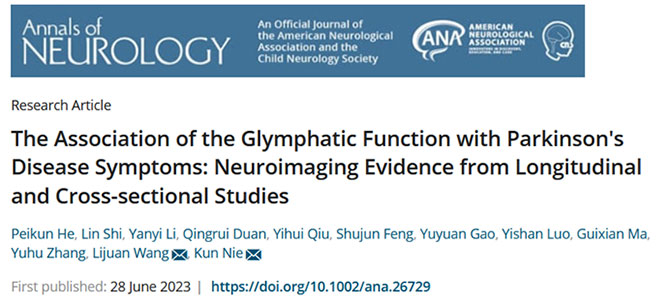The Team Led by Wang Lijuan and Nie Kun Finds that an Index Related to the Function of the Brain Glymphatic System Can Predict the Clinical Progression of Parkinson’s Disease
Our research team led by Wang Lijuan and Nie Kun from the Guangdong Neuroscience Institute and the Department of Neurology of our hospital made a significant breakthrough between the brain glymphatic system and the progression of Parkinson’s disease, and the research findings were published in the world-renowned journal Annals of Neurology (impact factor: 11.274). This study reveals for the first time that diffusion tensor image analysis along the perivascular space (ALPS-index) is correlated with the progression of motor and some non-motor symptoms of Parkinson’s disease (PD), providing clinical neuroimaging evidence for the involvement of the brain glymphatic system in PD progression.
PD is one of the most common neurodegenerative diseases. The pathological deposition and clearance disorder of α-synuclein (α-syn) are the core pathological processes of PD. The brain glymphatic system is a functional pipeline network in the brain that removes metabolic waste and deposited proteins. It can drain the glymphatic system between cerebrospinal and interstitial fluids through the perivascular space, drain the brain’s metabolic waste from the meningeal lymphatic vessels to the deep cervical lymph nodes, and then transport it out of the brain. Increasing evidence suggests that α-syn is removed through the glymphatic system, and obstructing the flow of cerebrospinal fluid in the brain glymphatic system will disrupt the dynamic balance formed between the generation and clearance of α-syn, leading to the abnormal aggregation of the latter, the accumulation of insoluble fibers in cells, the formation of Lewy bodies and Lewy neurites, neurotoxicity, and cell apoptosis.
Although mounting evidence shows that the function of the brain glymphatic system is closely associated with the pathological deposition of α-syn in PD, the relationship between the function of the brain glymphatic system and the progression of clinical symptoms of PD is still unclear. Focusing on the relationship between the function of the brain glymphatic system and the progression of clinical symptoms of PD, the team led by Wang Lijuan and Nie Kun published a research paper titled “The Association of the Glymphatic Function with Parkinson’s Disease Symptoms: Neuroimaging Evidence from Longitudinal and Cross-sectional Studies” in Annals of Neurology to conduct further research on the relationship between the function of the glymphatic system and clinical symptoms of PD through cross-sectional and longitudinal clinical trials. Guangdong Provincial People’s Hospital (the Guangdong Academy of Medical Sciences) is the first completing unit of this paper, 2021 doctoral student He Peikun from the South China University of Technology is a first author, Associate Chief Physician Nie Kun of the Department of Neurology and Wang Lijuan, Director of the Guangdong Neuroscience Institute, are the joint corresponding authors; in addition, Prof. Shi Lin from the Chinese University of Hong Kong is a joint first author.

This study retrospectively analyzed the clinical and imaging data of 289 PD patients who were treated at the Department of Neurology, Guangdong Provincial People’s Hospital, and the 5-year follow-up data of 95 patients diagnosed with PD from the Parkinson’s Progression Markers Initiative (PPMI) database. This study also evaluated the function of the brain glymphatic system through a noninvasive imaging method, namely the ALPS-index. (This study was approved by the Medical Ethics Committee, Guangdong Provincial People’s Hospital under the number KY2020-544-01, and the informed consent of all participants was obtained.) The ALPS-index was calculated from the diffusion rate of projection and associated fibers along the perivascular space in the lateral ventricles. A decrease in this index indicated a decrease in the diffusion rate of cerebrospinal fluid along the perivascular space, and could reflect a decrease in the function of the glymphatic system indirectly. The cross-sectional study analysis found that the ALPS-index was negatively correlated with the age, disease severity, drug dose, and motor function severity of PD patients; by using a linear mixed model to analyze longitudinal data, it was found that PD patients with lower ALPS-index values at baseline showed significant decreases in motor function, attention, working memory, executive function, and cognitive functions like memory during the 5-year follow-up period, after adjusting for age, gender, years of education, course of disease, drug dose, and average diffusion coefficient (a measure of white matter injury); additionally, the pathway analysis model further found that the ALPS-index might mediate the damage of the pathological protein tTau/Aβ1-42 ratio in cerebrospinal fluid to the cognitive functions of PD patients. Overall, this study reveals that the ALPS-index may serve as a neuroimaging marker for predicting and monitoring the progression of clinical symptoms of PD, and provides clinical evidence for brain glymphatic system injury as a potential mechanism of PD progression.
Department of Neurology
Updated: July 17, 2023


